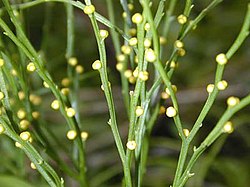Psilotales
| Psilotaceae | |
|---|---|
 |
|
| Closeup of Psilotum nudum | |
| Scientific classification | |
| Kingdom: | Plantae |
| Division: | Pteridophyta |
| Class: | Psilotopsida |
| Order: |
Psilotales Prantl |
| Family: |
Psilotaceae J.W. Griff. & Henfr. |
| Genera | |
Psilotaceae is a family of Pteridophyta (in order Psilotales) consisting of two genera, Psilotum and Tmesipteris with a dozen species.
The first genus, Psilotum, consists of small shrubby plants of the dry tropics commonly known as "Whisk ferns". The other genus, Tmesipteris, is an epiphyte found in Australia, New Zealand, and New Caledonia. Once thought to be descendants of the first vascular plants (the Psilophyta of the Devonian period), they have been shown by molecular phylogenetics to be ferns, a sister group of the Ophioglossaceae.
All Psilotaceae share a few characteristics. They are vascular plants and they lack leaves, having instead small outgrowths called enations. The enations are not considered true leaves because there is only a vascular bundle just underneath them, but not inside, as in leaves. Psilotales also do not have true roots. They are anchored by rhizoids. Absorption is aided by symbiotic fungi called mycorrhizae.
Three sporangia are united into a synangium, which is considered to be a very reduced series of branches. There is a thick tapetum to nourish the developing spores, as is typical of eusporangiate plants. The gametophyte looks like a small piece of subterranean stem, but produces antheridia and archegonia.
In the molecular phylogenetic classification of Smith et al. in 2006, Psilotales, containing the single family Psilotaceae comprising Psilotum and Tmesipteris, was placed with the order Ophioglossales in the class Psilotopsida. The linear sequence of Christenhusz et al. (2011), intended for compatibility with the classification of Chase and Reveal (2009) which placed all land plants in Equisetopsida, made it a member of subclass Ophioglossidae, equivalent to Smith's Psilotopsida. The placement of Psilotales in subclass Ophioglossidae has subsequently been followed in the classifications of Christenhusz and Chase (2014) and PPG I (2016).
...
Wikipedia
